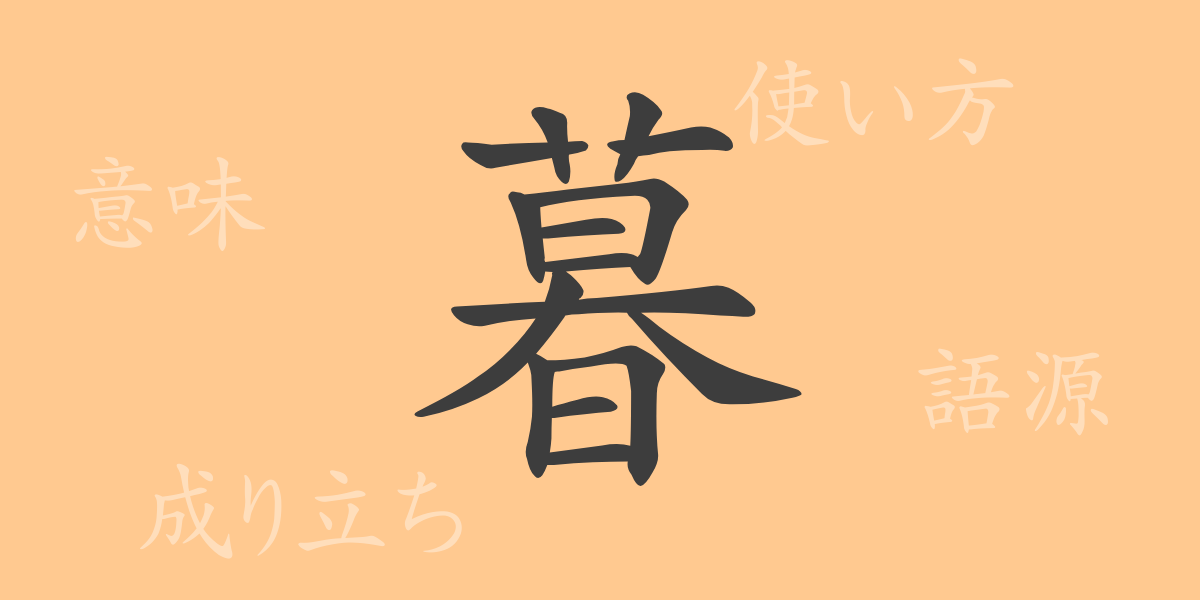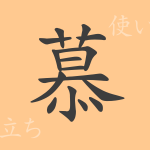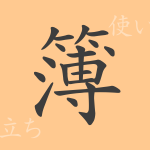The beauty of the Japanese language lies in its rich expressions. Particularly, the meaning embedded in a single kanji character evokes a deep sense of history and culture. “暮” (くれ, kure) is one such commonly used kanji, intricately tied to our daily lives. In this article, we delve into the origins, meanings, usage, and even the idioms and proverbs associated with “暮” (くれ, kure).
The Origin (語源, Gogen) of “暮” (くれ, kure)
The kanji “暮” (くれ, kure) evolved from pictographs depicting the setting sun. In ancient China, it was used to signify the time of sunset, and over time, it came to encompass meanings related to the passage of time and daily living. From the idea of the sun setting, it extended to signify the end of a day or even the end of a year.
The Meaning and Usage of “暮” (くれ, kure)
“暮” (くれ, kure) is related to the verbs “くらす” (くらす, kurasu) and “くれる” (くれる, kureru), which mean to live or spend one’s days, and to the setting of the sun. Specifically, it is used to express situations such as “to live,” “time passing,” and “years passing.” It can also be seen in expressions indicating the change of seasons, such as “春暮れて” (はるくれて, haru kurete), meaning “spring is ending.”
Readings, Stroke Count, and Radical of “暮” (くれ, kure)
The kanji “暮” (くれ, kure) has basic information such as readings, stroke count, and radical.
- Readings: On’yomi (音読み, on’yomi) is “ボ” (ぼ, bo), Kun’yomi (訓読み, kun’yomi) are “く.れる” (くれる, kureru) and “く.らす” (くらす, kurasu)
- Stroke count: 14 strokes in total
- Radical: 日部 (にちへん, nichi hen)
Idioms, Phrases, and Proverbs Using “暮” (くれ, kure) and Their Meanings
There are numerous idioms, phrases, and proverbs that include “暮” (くれ, kure). Each of these words reflects aspects of Japanese life and philosophy.
- 暮らし (くらし, kurashi): To live or make a living. “彼は質素な暮らしをしている” (かれはしっそなくらしをしている, Kare wa shisso na kurashi o shite iru) – “He lives a frugal life.”
- 年の暮 (としのくれ, toshi no kure): The end of the year. “年の暮れには帰省する” (としのくれにはきせいする, Toshi no kure ni wa kisei suru) – “I go back to my hometown at the end of the year.”
- 暮れなずむ (くれなずむ, kurenazumu): The lingering twilight. “夕暮れ時に暮れなずんでいく空” (ゆうぐれどきにくれなずんでいくそら, Yuugure toki ni kurenazunde iku sora) – “The sky lingering into twilight during dusk.”
- 手暮らし (てぐらし, tegurashi): Making a living with one’s own hands. “彼女は手暮らしで子どもを育てている” (かのじょはてぐらしでこどもをそだてている, Kanojo wa tegurashi de kodomo o sodatete iru) – “She is raising her children by making a living with her own hands.”
- 暮し向き (くらしむき, kurashimuki): The state or standard of living. “暮し向きが良くなった” (くらしむきがよくなった, Kurashimuki ga yoku natta) – “The standard of living has improved.”
Summary on “暮” (くれ, kure)
The kanji “暮” (くれ, kure) is an important character that represents familiar concepts such as our daily lives and the passage of time. Understanding its rich meanings and usages allows us to appreciate the depth of the Japanese language even more. When you encounter words using “暮” (くれ, kure) in your daily life, try to think of the history and culture behind it.

























